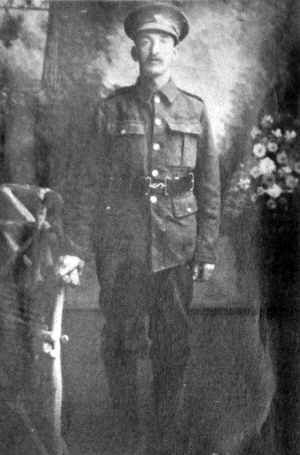
In 1911, Fred Brammer, who was born near Barnsley in 1886 was living at 8, Workhouse Yard, Flushdyke, Ossett with his wife Emma (nee Marshall) and their young son Sydney, who was born in 1909. The couple had married in Ossett in 1908 and Fred was working as a rag shaker at a nearby mill.
Fred’s father James Brammer and his two brothers George and Herbert all lived at Birdwell, Barnsley, but Fred’s two married sisters Harriet Hinchcliffe and Annie Elizabeth Garforth both lived in Ossett. Harriet and her husband lived next door to Fred and his wife at 7, Workhouse Yard.
Initially, Fred enlisted with the King’s Own Yorkshire Light Infantry, service number 33376, on the 24th July 1916 and his service record shows that he was “at home” until the 8th December 1916, when he was posted to France. He must have transferred to the East Yorkshire Regiment sometime after arriving in France, but the actual date and circumstances are not known.
Fred Brammer was killed in action on the 9th April 1917, aged 30 years, at the first Battle of the Scarpe, the opening battle of the Arras campaign. The 8th Battalion of the East Yorkshire Regiment, as a part of the Allied 3rd Division, were involved in the capture of Monchy le Preux and the Wancourt Ridge against strong German opposition in blizzard conditions. Many years after the end of WW1, Arthur Laycock, from South Ossett, who fought in the Great War with Fred Brammer gave an account of Fred’s death to his grandson Douglas Brammer. Arthur Laycock told the story that they were in a farmyard in a small trench that they had dug for protection and were having a cigarette when Fred Brammer was shot and killed by a German sniper.
Monchy-le-Preux was one of the keys to the northern end of the Hindenburg Line, giving the Germans ideal observation over any advance from the British trenches in front of Arras five miles away. Third Army’s commander, General Sir Edmund Allenby, ordered the capture of the village and surrounding high ground, as objectives for the first day of the offensive on the 9th April.

Above: Map of the battlefield where Fred Brammer was killed on the 9th April 1917. The “battle” marker in the top left-hand part of the map alongside the D939 Route Nationale main road shows the site of the battle involving the 8th Battalion of the East Yorkshire Regiment.
He is buried at Cojeul British Cemetery, St. Martin-sur-Cojeul in the Pas de Calais area of France. Cojeul British Cemetery1 was begun by the 21st Division Burial Officer in April 1917, and used by fighting units until the following October. It was very severely damaged in later fighting. The cemetery contains 349 burials and commemorations of the First World War. 35 of the burials are unidentified and 31 graves destroyed by shell fire are represented by special memorials.

Above: Emma Brammer’s moving tribute to her dead husband.
On the 5th July 1917, the Army wrote to Fred Brammer’s widow Emma to return his personal belongings, adding that “these are the only articles forthcoming.” They returned a letter and an identity disc. On the 29th October 1917, Fred’s widow Emma was awarded a pension of 18s and 9d a week for her and their eight year old child Sydney Brammer.
References: